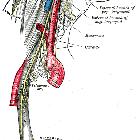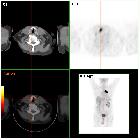Nervus laryngeus recurrens

A radiologic
review of hoarse voice from anatomic and neurologic perspectives. Representative coronal (a) and axial (b, c) illustrations demonstrating the normal course of the bilateral vagus and recurrent laryngeal nerves. The right recurrent laryngeal nerve loops posteromedially under the right subclavian artery (a, b), and the left recurrent laryngeal nerve loops posteromedially beneath the aortic arch (a, c)

Vagusgruppe,
Image:Gray793.png, nachbearbeitet und Beschriftung modifiziert (Deutsch/german) von de:Benutzer:Uwe Gille

Course and
distribution of the glossopharyngeal, vagus, and accessory nerves.

desc}} ==
{{Gray"s Anatomy plate}} == {{int:license-header}} == {{PD-US}} [[Category:Media missing infobox template]] {{Check categories|year=2015|month=January|day=1 |gallery1=Gray"s Anatomy plates |ncats=1 }} [[Category:Gray"s Ana
The recurrent laryngeal nerve (RLN), also known as the inferior laryngeal nerve, is a branch of the vagus nerve (CN X) which has a characteristic loop around the right subclavian artery on the right and the aortic arch on the left before returning up to achieve the tracheoesophageal groove and then the larynx.
Summary
- location: superior mediastinum and the lower neck regions
- origin and course: originates from the vagus nerve (CN X)
- on the right side, the RLN exits anteriorly to the subclavian artery and travels inferiorly and posteriorly under the artery before ascending through the neck between the trachea and the esophagus
- on the left side, the RLN exits at the aortic arch level and courses posteromedially beneath it before looping through the aorticopulmonary window, posterior to the ligamentum arteriosum
- the nerve then has a symmetric ascending vertical course in the tracheo-esophageal groove, adjacent to the medial surface of the lobes of the thyroid gland
- courses below the inferior border of the inferior pharyngeal constrictor muscle to enter the larynx posterior to the cricothyroid joint
- branches and supply
- motor supply to all the intrinsic muscles of the larynx except the cricothyroid muscle, which is supplied by the external laryngeal nerve
- sensory and secretomotor supply to the laryngeal mucosal structures below the level of the vocal cords and trachea
- relations: right subclavian artery on the right side and aortic arch on the left
- variants: non-recurrent laryngeal nerve
Siehe auch:
und weiter:

 Assoziationen und Differentialdiagnosen zu Nervus laryngeus recurrens:
Assoziationen und Differentialdiagnosen zu Nervus laryngeus recurrens:

